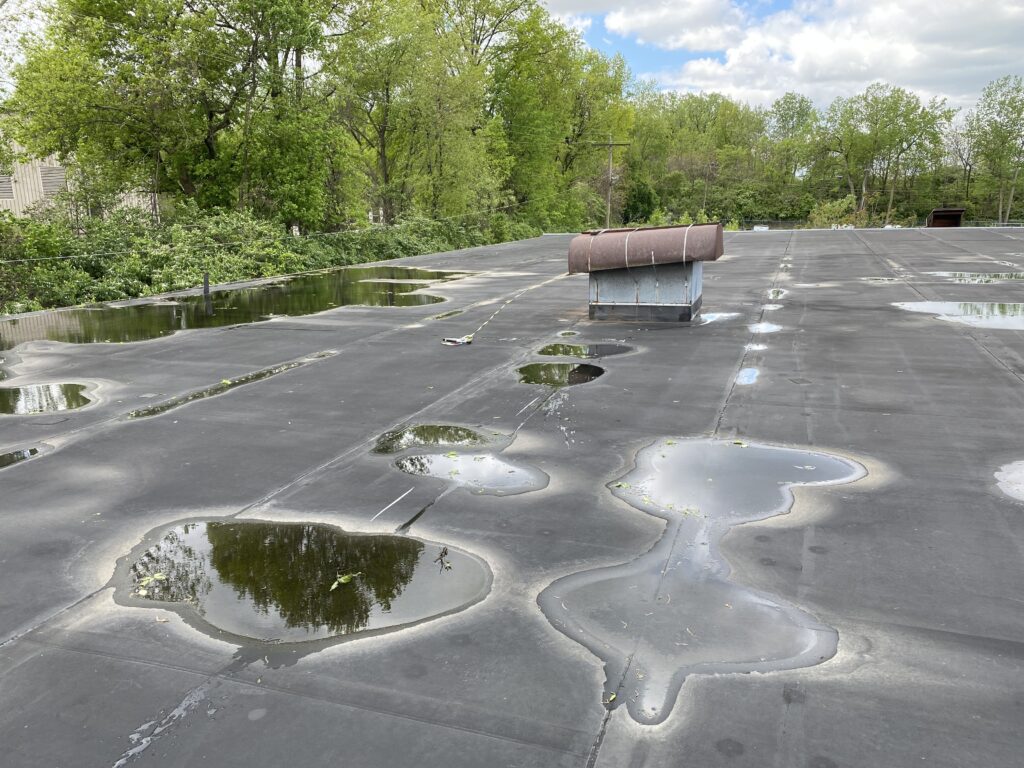Preventing ponding on flat commercial roofs is essential to maintaining your roof’s structural integrity and preventing water damage. Ponding occurs when water accumulates and remains stagnant on the roof surface, potentially leading to leaks, deterioration of roofing materials, and even structural issues.
In this blog post, we’ll explore 10 effective strategies that will help to prevent ponding and maintain the integrity of flat commercial roofs.
Proper Roof Design & Slope
Ensure your roof is designed with a slight slope to encourage proper drainage. While flat roofs may not have a steep pitch, they should still have enough slop to direct water toward designated draining points, reducing the likelihood of ponding.
Effective Drainage Systems
An efficient drainage system is crucial for diverting water off the roof. Install a reliable drainage system for your roof, including gutters, downspouts, and roof drains. This system will allow the water to carry away from the roof surface. Make sure to regularly clean and inspect these components to prevent clogs and blockages.
Regular Roof Inspections
Conduct routine inspections to identify areas where water may be pooling. Beware of low spots, uneven surfaces, or areas with inadequate drainage during these inspections.
Quality Roofing Materials
Choosing high-quality roofing materials designed to withstand ponding water and that have good waterproofing properties are essential to the health of your roof. Materials like EPDM, TPO, PVC, and modified bitumen are popular choices for flat commercial roofs due to their ability to withstand water accumulation.
Proper Installation
Even the best materials won’t perform well if not installed correctly. Ensure you install the materials according to the manufacturer’s guidelines and industry best practices. Proper installation can help prevent the formation of low spots and promote water drainage.
Reinforce Low Areas
Reinforce areas that are prone to ponding due to structural limitations. Consider additional roofing materials or tapered insulation systems to encourage water flow.
Roof Coatings
Applying reflective or elastomeric roof coatings can help improve the water-shedding ability of the roof and provide an additional layer of protection against water damage.
Regular Maintenance
Keep your roof clean and clear of debris that can block drainage pathways. Regular maintenance can prevent leaves, branches, and other debris from accumulating and causing water to pool. Regular inspections, gutter cleaning, and prompt removal are essential to the health of your roof.
Consult Professionals
Roofing contractors or engineers specializing in flat roofing systems such as ASI ensure your roof is properly designed, installed, and maintained to prevent ponding issues.
Address Existing Ponding
If you’ve already noticed ponding on your roof, take immediate action. Consider regrading to create proper slopes. Additionally, identify and address any structural issues contributing to the ponding.
Preventing ponding on flat commercial roofs requires a comprehensive approach involving proper design, installation, and ongoing maintenance. By following these strategies and seeking professional guidance, you can maintain the integrity of your flat roof, protect your investment, and ensure the longevity of your commercial building. Don’t overlook the importance of preventing ponding – it’s a crucial aspect of roof management that pays off in the long run.
If your commercial roof isn’t regularly inspected, issues can go undetected for months before you notice that there’s a problem. Don’t wait until it’s too late. Contact our ASI Roofing team today to get your seasonal inspection scheduled! Click here or call 614-873-2057.

